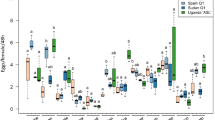Abstract
In agriculture, although it is important to identify species of pest insects, their morphological identification is often difficult. DNA genotyping is useful for identifying morphologically indiscriminable species. Thrips tabaci Lindeman has two reproductive modes (arrhenotoky and thelytoky), which differ in their pesticide resistance, but morphological discrimination is not possible. Studies have established a simple method of discriminating the strains by using their mitochondrial DNA sequences. Previous studies have placed so-called arrhenotokous individuals into a “polyphagous thelytokous clade.” We made the discovery of new arrhenotokous strains that place them in the thelytokous monophyletic group. We show that this polyphagous thelytokous clade is not a monophyletic group. Therefore, the methods currently used to distinguish thelytokous and arrhenotokous individuals need to be updated, and we need to detect another region of DNA that will enable us to discriminate between the two types.

Similar content being viewed by others
References
Brunner PC, Chatzivassiliou EK, Katis NI, Frey JE (2004) Host-associated genetic differentiation in Thrips tabaci (Insecta; Thysanoptera), as determined from mtDNA sequence data. Heredity 93:364–370
Chatzivassiliou EK, Nagata T, Peters D, Katis NI (1999) The transmission of tomato spotted wilt tospovirus (TSWV) by Thrips tabaci Lind. (Thysamnopera: Thripidae) populations originating from leek. Plant Pathol 48:700–706
Chatzivassiliou EK, Peters D, Katis NI (2002) The efficiency by which Thrips tabaci populations transmit tomato spotted wilt virus depends on their host preference and reproductive strategy. Phytopathol 92:603–609
Inoue T, Sakurai T (2007) The phylogeny of thrips (Thysanoptera: Thripidae) based on partial sequences of cytochrome oxidase I, 28S ribosomal DNA and elongation factor-1α and the association with vector competence of tospoviruses. Appl Entomol Zool 42:71–81
Jacobson AL, Booth W, Vargo EL, Kennedy GG (2013) Thrips tabaci population genetic structure and polyploidy in relation to competency as a vector of tomato spotted wilt virus. Plos One 8: doi:10.1371/journal.pone.0054484
Kendall DM, Capinera JL (1990) Geographic and temporal variation in the sex ratio of onion thrips. Southwest Entomol 15:80–88
Kobayashi K, Hasegawa E (2012) Discrimination of reproductive forms of Thrips tabaci (Thysanoptera: Thripidae) by PCR With sequence speciftc primers. J Econ Entomol 105:555–559
Kobayashi K, Yoshimura J, Hasegawa E (2013) Coexistence of sexual individuals and genetically isolated asexual counterparts in a thrips. Sci Report. doi:10.1038/srep03286
Lewis T (1973) Thrips: their biology, ecology and economic importance. Academic Press, London
Lewis T (1997) Flight and dispersal. In: Lewis T (ed) Thrips as crop pests. CAB International, Wallingford, pp 175–196
Mallet J (2007) Hybrid speciation. Nature 446:279–283
Miura K, Tagamai Y, Ohtaishi M, Iwasaki A (2004) Application of molecular techniques to distinguish Liriomyza trifolii from L. sativae (Diptera: Agromyzidae) on tomato cultivation in Japan. J Econ Entomol 97:964–969
Murai T, Loomans AJM (2001) Evaluation of an improved method for mass-rearing of thrips and a thrips parasitoid. Entomol Exp Appl 101:281–289
Nault BA, Shelton AM, Gangloff-Kaufmann JL, Clark ME, Werren JH, Cabrera-La Rosa JC, Kennedy GG (2006) Reproductive modes in onion Thrips (Thysanoptera: Thripidae) populations from New York onion fields. Environ Entomol 35:1264–1271
Palumbi SR (1996) Nucleic acids II: the polymerase chain reaction. In: Hillis DM, Moritz C, Mable BK (eds) Molecular systematics, 2nd edn. Sinauer Associates, Massachusetts, pp 205–246
Parrella MP, Keil CB (1984) Insect pest management: the lesson of Liriomyza. Bull Entomol Soc Am 30:22–25
Rossman AY, Miller DR (1996) Systematics solves problems in agriculture and forestry. Ann Missouri Botanical Garden 83:17–28
Scheffer SJ (2000) Molecular evidence of cryptic species within the Liriomyza huidobrensis (Diptera: agromyzidae). J Econ Entomol 93:1146–1151
Scheffer SJ, Lewis ML (2001) Two nuclear genes confirm mitochondrial evidence of cryptic species within Liriomyza huidobrensis (Diptera: agromyzidae). Ann Entomol Soc Am 94:648–653
Sota T, Vogler AP (2001) Incongruence of mitochondrial and nuclear gene trees in the carabid beetles Ohomopterus. Syst Biol 50:39–59
Stouthamer R, Luck RF, Hamilton WD (1990) Antibiotics cause parthenogenetic Trichogramma (Hymenoptera/Trichogrammatidae) to revert to sex. Proc Natl Acad Sci USA 87:2424–2427
Suomalainen E, Saura A (1993) Patterns of reproduction in insects. In: Wrensch DL, Ebbert MA (eds) Evolution and diversity of sex ratio in insects and mites. Chapman & Hall, New York, pp 100–117
Takeuchi R, Toda S (2011) Discrimination of two reproductive forms of Thrips tabaci by PCR-RFLP, and distribution of arrhenotokous T. tabaci in Tottori Prefecture. Jpn J Appl Entomol Zool 55:254–257
Tamura K, Peterson D, Peterson N, Stecher G, Nei M, Kumar S (2011) MEGA5: Molecular Evolutionary Genetics Analysis using Maximum Likelihood, Evolutionary Distance, and Maximum Parsimony Methods. Mol Biol Evol 28:2731–2739
Thompson JD, Higgins DG, Gibson TJ (1994) CLUSTAL W: Improving the sensitivity of progressive multiple sequence alignment through sequence weighting, positions-specific gap penalties and weight matrix choice. Nucl Acid Res 22:4673–4680
Toda S, Morishita M (2009) Identification of three point mutations on the sodium channel gene in pyrethroid-resistant Thrips tabaci (Thysanoptera: Thripidae). J Econ Entomol 102:2296–2300
Toda S, Murai T (2007) Phylogenetic analysis based on mitochondrial COI gene sequences in Thrips tabaci Lindeman (Thysanoptera: Thripidae) in relation to reproductive forms and geographic distribution. Appl Entomol Zool 42:309–316
Torres-Vila LM, Lacasa A, Bielza P, Meco R (1994) Dinamica poblacional de Thrips tabaci Lindeman (Thysanoptera: Thripidae) sobre liliaceas horticolas en Castilla-La Mancha. Boletin de Sanidad Vegetal Plagas 20:661–677
Weisburg WG, Barns SM, Pelletier DA, Lane DJ (1991) 16S ribosomal DNA amplification for phylogenetic study. J Bacteriol 173:697–703
Westmore GC, Poke FS, Allen GR, Wilson CR (2013) Thrips tabaci Lindeman (Thysanoptera: Thripidae) and its links to Tomato spotted wilt virus-vector competence. Heredity 111:210–215
Wijkamp I, Almarza N, Coldbach R, Peter D (1995) Distinct levels of specificity in thrips transmission of tospoviruses. Phytopathol 85:1069–1074
Zhang DX, Hewitt GM (1996) Assessment of the universality and utility of a set of conserved mitochondrial COI primers in insects. Insect Mol Biol 6:143–150
Author information
Authors and Affiliations
Corresponding author
Rights and permissions
About this article
Cite this article
Sogo, K., Miura, K., Aizawa, M. et al. Genetic structure in relation to reproduction mode in Thrips tabaci (Insecta: Thysanoptera). Appl Entomol Zool 50, 73–77 (2015). https://doi.org/10.1007/s13355-014-0306-7
Received:
Accepted:
Published:
Issue Date:
DOI: https://doi.org/10.1007/s13355-014-0306-7




